Healthcare Policy Report: Healthcare Policy and EHR Security
VerifiedAdded on 2022/08/12
|6
|1704
|54
Report
AI Summary
This report delves into the critical aspects of healthcare policy, specifically focusing on the security of Electronic Health Records (EHRs). The introduction highlights the transformative impact of technological innovations, particularly EHRs, on managing various healthcare functions and patient care. The central problem identified is the need for robust security measures to protect sensitive patient data. The report emphasizes the importance of developing comprehensive security policies to safeguard patient information, including financial data, from potential breaches and unauthorized access. It discusses the advantages of EHR systems in managing patient appointments, medical history, and medication records while underscoring the necessity of security frameworks like ISO 27001 and ISO 31000. The report also addresses the ethical and legal considerations of data security, emphasizing the need for compliance with regulations. Finally, the report concludes by advocating for the implementation of data security policies across all healthcare organizations to ensure the confidentiality and integrity of patient information and improve the overall quality of care. The report highlights the benefits of EHRs and the necessity of security measures to avoid data breaches, protect patient data, and ensure that the system is used ethically and legally.
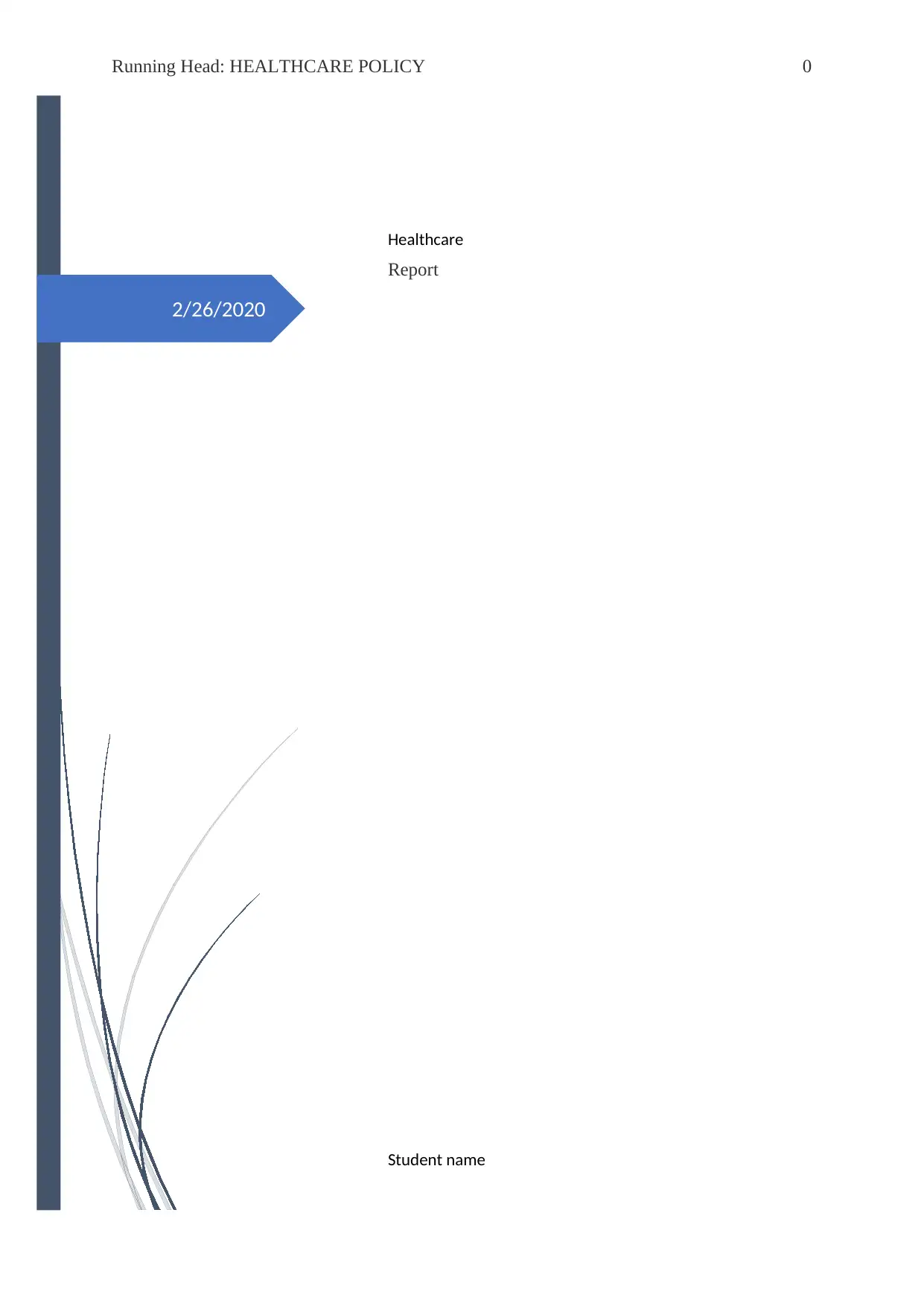
2/26/2020
Running Head: HEALTHCARE POLICY 0
Healthcare
Report
Student name
Running Head: HEALTHCARE POLICY 0
Healthcare
Report
Student name
Paraphrase This Document
Need a fresh take? Get an instant paraphrase of this document with our AI Paraphraser
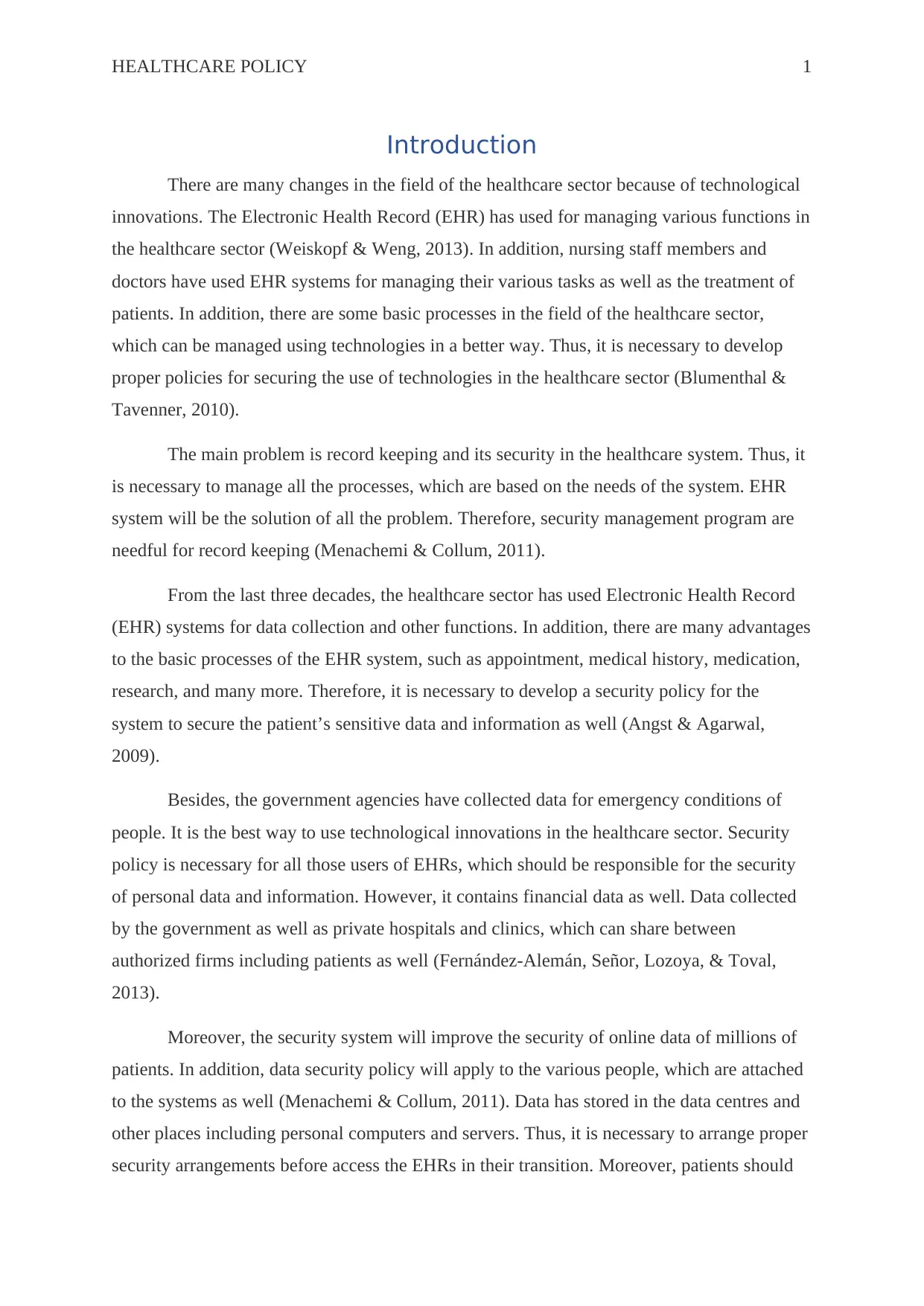
HEALTHCARE POLICY 1
Introduction
There are many changes in the field of the healthcare sector because of technological
innovations. The Electronic Health Record (EHR) has used for managing various functions in
the healthcare sector (Weiskopf & Weng, 2013). In addition, nursing staff members and
doctors have used EHR systems for managing their various tasks as well as the treatment of
patients. In addition, there are some basic processes in the field of the healthcare sector,
which can be managed using technologies in a better way. Thus, it is necessary to develop
proper policies for securing the use of technologies in the healthcare sector (Blumenthal &
Tavenner, 2010).
The main problem is record keeping and its security in the healthcare system. Thus, it
is necessary to manage all the processes, which are based on the needs of the system. EHR
system will be the solution of all the problem. Therefore, security management program are
needful for record keeping (Menachemi & Collum, 2011).
From the last three decades, the healthcare sector has used Electronic Health Record
(EHR) systems for data collection and other functions. In addition, there are many advantages
to the basic processes of the EHR system, such as appointment, medical history, medication,
research, and many more. Therefore, it is necessary to develop a security policy for the
system to secure the patient’s sensitive data and information as well (Angst & Agarwal,
2009).
Besides, the government agencies have collected data for emergency conditions of
people. It is the best way to use technological innovations in the healthcare sector. Security
policy is necessary for all those users of EHRs, which should be responsible for the security
of personal data and information. However, it contains financial data as well. Data collected
by the government as well as private hospitals and clinics, which can share between
authorized firms including patients as well (Fernández-Alemán, Señor, Lozoya, & Toval,
2013).
Moreover, the security system will improve the security of online data of millions of
patients. In addition, data security policy will apply to the various people, which are attached
to the systems as well (Menachemi & Collum, 2011). Data has stored in the data centres and
other places including personal computers and servers. Thus, it is necessary to arrange proper
security arrangements before access the EHRs in their transition. Moreover, patients should
Introduction
There are many changes in the field of the healthcare sector because of technological
innovations. The Electronic Health Record (EHR) has used for managing various functions in
the healthcare sector (Weiskopf & Weng, 2013). In addition, nursing staff members and
doctors have used EHR systems for managing their various tasks as well as the treatment of
patients. In addition, there are some basic processes in the field of the healthcare sector,
which can be managed using technologies in a better way. Thus, it is necessary to develop
proper policies for securing the use of technologies in the healthcare sector (Blumenthal &
Tavenner, 2010).
The main problem is record keeping and its security in the healthcare system. Thus, it
is necessary to manage all the processes, which are based on the needs of the system. EHR
system will be the solution of all the problem. Therefore, security management program are
needful for record keeping (Menachemi & Collum, 2011).
From the last three decades, the healthcare sector has used Electronic Health Record
(EHR) systems for data collection and other functions. In addition, there are many advantages
to the basic processes of the EHR system, such as appointment, medical history, medication,
research, and many more. Therefore, it is necessary to develop a security policy for the
system to secure the patient’s sensitive data and information as well (Angst & Agarwal,
2009).
Besides, the government agencies have collected data for emergency conditions of
people. It is the best way to use technological innovations in the healthcare sector. Security
policy is necessary for all those users of EHRs, which should be responsible for the security
of personal data and information. However, it contains financial data as well. Data collected
by the government as well as private hospitals and clinics, which can share between
authorized firms including patients as well (Fernández-Alemán, Señor, Lozoya, & Toval,
2013).
Moreover, the security system will improve the security of online data of millions of
patients. In addition, data security policy will apply to the various people, which are attached
to the systems as well (Menachemi & Collum, 2011). Data has stored in the data centres and
other places including personal computers and servers. Thus, it is necessary to arrange proper
security arrangements before access the EHRs in their transition. Moreover, patients should
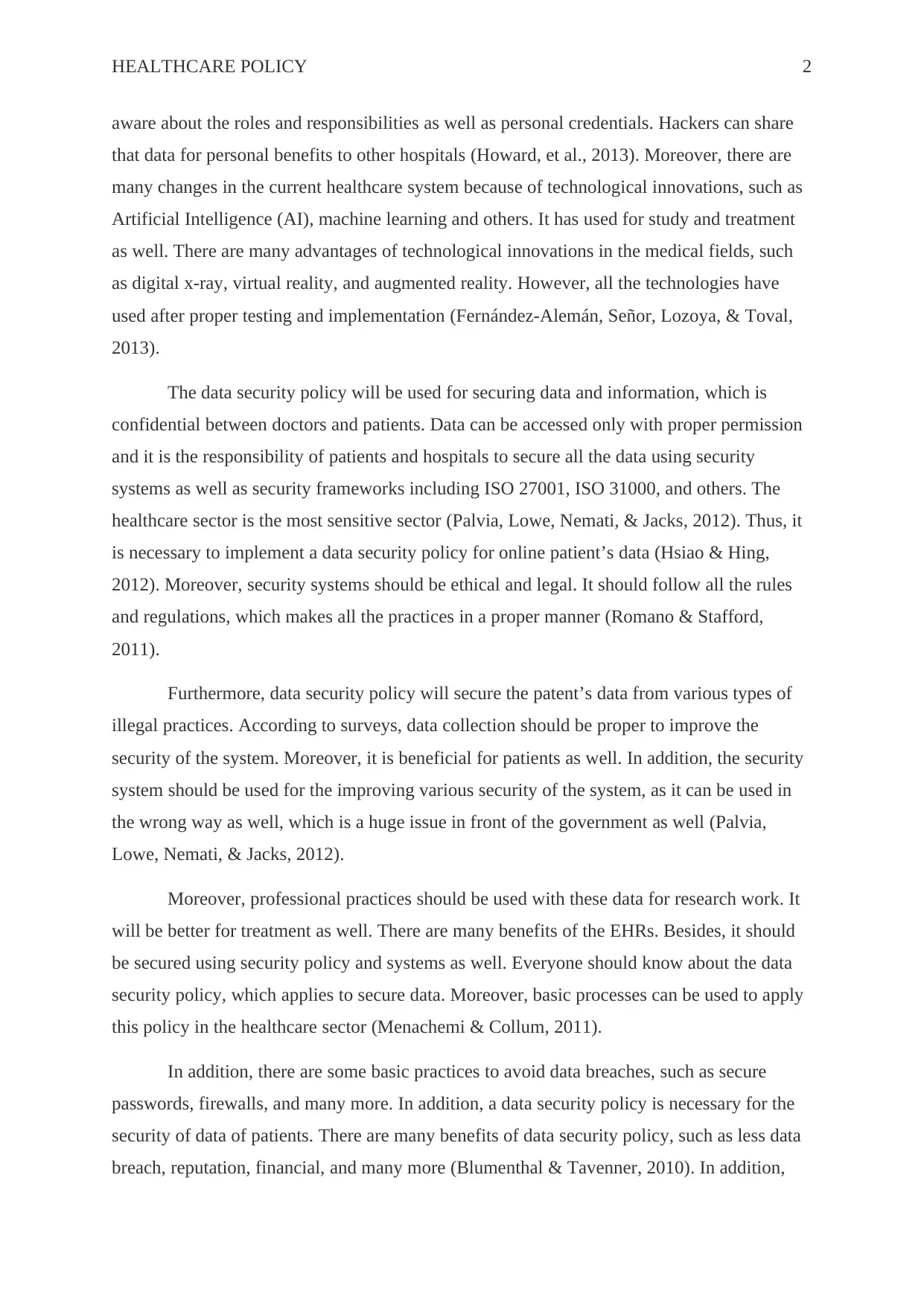
HEALTHCARE POLICY 2
aware about the roles and responsibilities as well as personal credentials. Hackers can share
that data for personal benefits to other hospitals (Howard, et al., 2013). Moreover, there are
many changes in the current healthcare system because of technological innovations, such as
Artificial Intelligence (AI), machine learning and others. It has used for study and treatment
as well. There are many advantages of technological innovations in the medical fields, such
as digital x-ray, virtual reality, and augmented reality. However, all the technologies have
used after proper testing and implementation (Fernández-Alemán, Señor, Lozoya, & Toval,
2013).
The data security policy will be used for securing data and information, which is
confidential between doctors and patients. Data can be accessed only with proper permission
and it is the responsibility of patients and hospitals to secure all the data using security
systems as well as security frameworks including ISO 27001, ISO 31000, and others. The
healthcare sector is the most sensitive sector (Palvia, Lowe, Nemati, & Jacks, 2012). Thus, it
is necessary to implement a data security policy for online patient’s data (Hsiao & Hing,
2012). Moreover, security systems should be ethical and legal. It should follow all the rules
and regulations, which makes all the practices in a proper manner (Romano & Stafford,
2011).
Furthermore, data security policy will secure the patent’s data from various types of
illegal practices. According to surveys, data collection should be proper to improve the
security of the system. Moreover, it is beneficial for patients as well. In addition, the security
system should be used for the improving various security of the system, as it can be used in
the wrong way as well, which is a huge issue in front of the government as well (Palvia,
Lowe, Nemati, & Jacks, 2012).
Moreover, professional practices should be used with these data for research work. It
will be better for treatment as well. There are many benefits of the EHRs. Besides, it should
be secured using security policy and systems as well. Everyone should know about the data
security policy, which applies to secure data. Moreover, basic processes can be used to apply
this policy in the healthcare sector (Menachemi & Collum, 2011).
In addition, there are some basic practices to avoid data breaches, such as secure
passwords, firewalls, and many more. In addition, a data security policy is necessary for the
security of data of patients. There are many benefits of data security policy, such as less data
breach, reputation, financial, and many more (Blumenthal & Tavenner, 2010). In addition,
aware about the roles and responsibilities as well as personal credentials. Hackers can share
that data for personal benefits to other hospitals (Howard, et al., 2013). Moreover, there are
many changes in the current healthcare system because of technological innovations, such as
Artificial Intelligence (AI), machine learning and others. It has used for study and treatment
as well. There are many advantages of technological innovations in the medical fields, such
as digital x-ray, virtual reality, and augmented reality. However, all the technologies have
used after proper testing and implementation (Fernández-Alemán, Señor, Lozoya, & Toval,
2013).
The data security policy will be used for securing data and information, which is
confidential between doctors and patients. Data can be accessed only with proper permission
and it is the responsibility of patients and hospitals to secure all the data using security
systems as well as security frameworks including ISO 27001, ISO 31000, and others. The
healthcare sector is the most sensitive sector (Palvia, Lowe, Nemati, & Jacks, 2012). Thus, it
is necessary to implement a data security policy for online patient’s data (Hsiao & Hing,
2012). Moreover, security systems should be ethical and legal. It should follow all the rules
and regulations, which makes all the practices in a proper manner (Romano & Stafford,
2011).
Furthermore, data security policy will secure the patent’s data from various types of
illegal practices. According to surveys, data collection should be proper to improve the
security of the system. Moreover, it is beneficial for patients as well. In addition, the security
system should be used for the improving various security of the system, as it can be used in
the wrong way as well, which is a huge issue in front of the government as well (Palvia,
Lowe, Nemati, & Jacks, 2012).
Moreover, professional practices should be used with these data for research work. It
will be better for treatment as well. There are many benefits of the EHRs. Besides, it should
be secured using security policy and systems as well. Everyone should know about the data
security policy, which applies to secure data. Moreover, basic processes can be used to apply
this policy in the healthcare sector (Menachemi & Collum, 2011).
In addition, there are some basic practices to avoid data breaches, such as secure
passwords, firewalls, and many more. In addition, a data security policy is necessary for the
security of data of patients. There are many benefits of data security policy, such as less data
breach, reputation, financial, and many more (Blumenthal & Tavenner, 2010). In addition,
⊘ This is a preview!⊘
Do you want full access?
Subscribe today to unlock all pages.

Trusted by 1+ million students worldwide
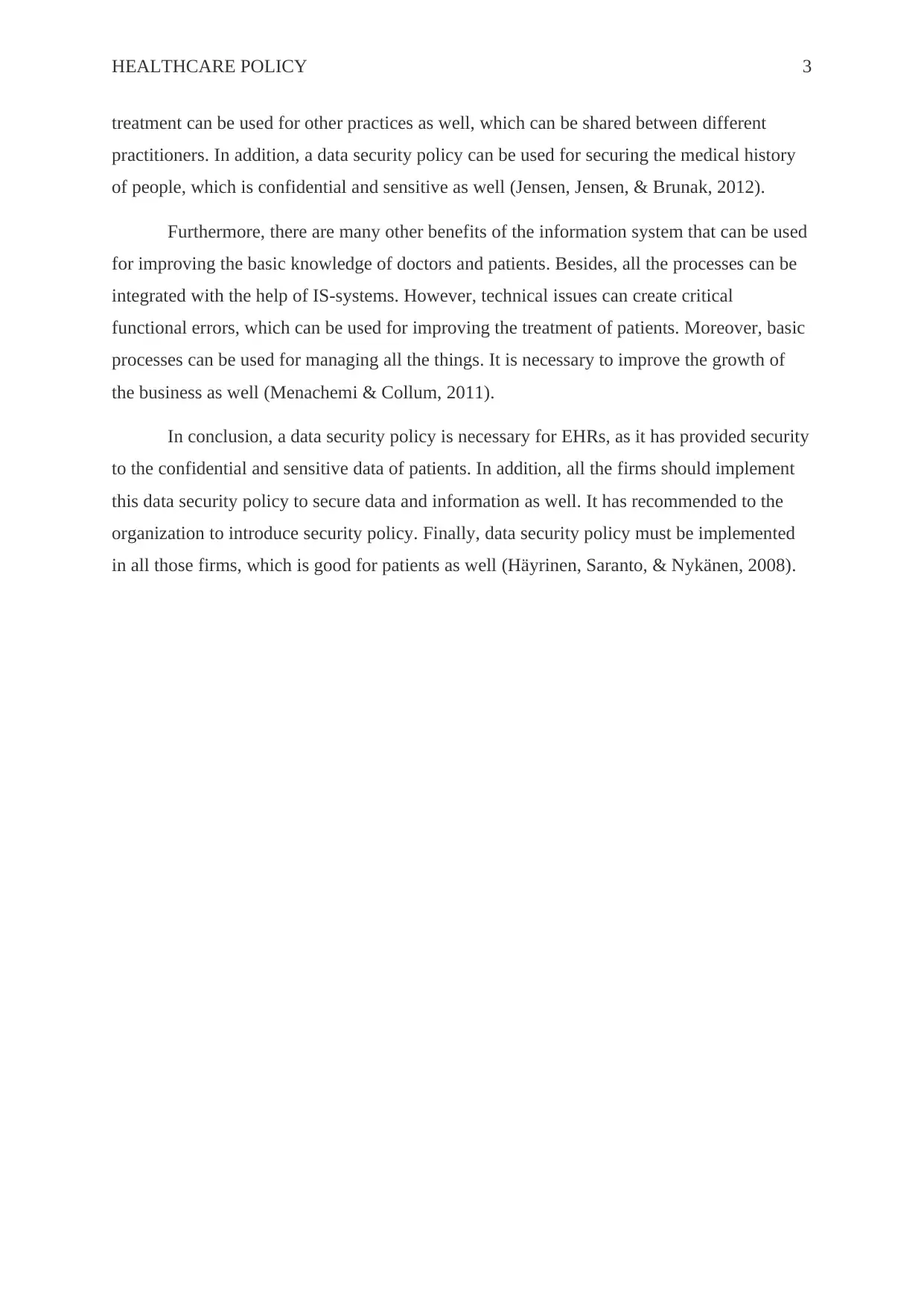
HEALTHCARE POLICY 3
treatment can be used for other practices as well, which can be shared between different
practitioners. In addition, a data security policy can be used for securing the medical history
of people, which is confidential and sensitive as well (Jensen, Jensen, & Brunak, 2012).
Furthermore, there are many other benefits of the information system that can be used
for improving the basic knowledge of doctors and patients. Besides, all the processes can be
integrated with the help of IS-systems. However, technical issues can create critical
functional errors, which can be used for improving the treatment of patients. Moreover, basic
processes can be used for managing all the things. It is necessary to improve the growth of
the business as well (Menachemi & Collum, 2011).
In conclusion, a data security policy is necessary for EHRs, as it has provided security
to the confidential and sensitive data of patients. In addition, all the firms should implement
this data security policy to secure data and information as well. It has recommended to the
organization to introduce security policy. Finally, data security policy must be implemented
in all those firms, which is good for patients as well (Häyrinen, Saranto, & Nykänen, 2008).
treatment can be used for other practices as well, which can be shared between different
practitioners. In addition, a data security policy can be used for securing the medical history
of people, which is confidential and sensitive as well (Jensen, Jensen, & Brunak, 2012).
Furthermore, there are many other benefits of the information system that can be used
for improving the basic knowledge of doctors and patients. Besides, all the processes can be
integrated with the help of IS-systems. However, technical issues can create critical
functional errors, which can be used for improving the treatment of patients. Moreover, basic
processes can be used for managing all the things. It is necessary to improve the growth of
the business as well (Menachemi & Collum, 2011).
In conclusion, a data security policy is necessary for EHRs, as it has provided security
to the confidential and sensitive data of patients. In addition, all the firms should implement
this data security policy to secure data and information as well. It has recommended to the
organization to introduce security policy. Finally, data security policy must be implemented
in all those firms, which is good for patients as well (Häyrinen, Saranto, & Nykänen, 2008).
Paraphrase This Document
Need a fresh take? Get an instant paraphrase of this document with our AI Paraphraser
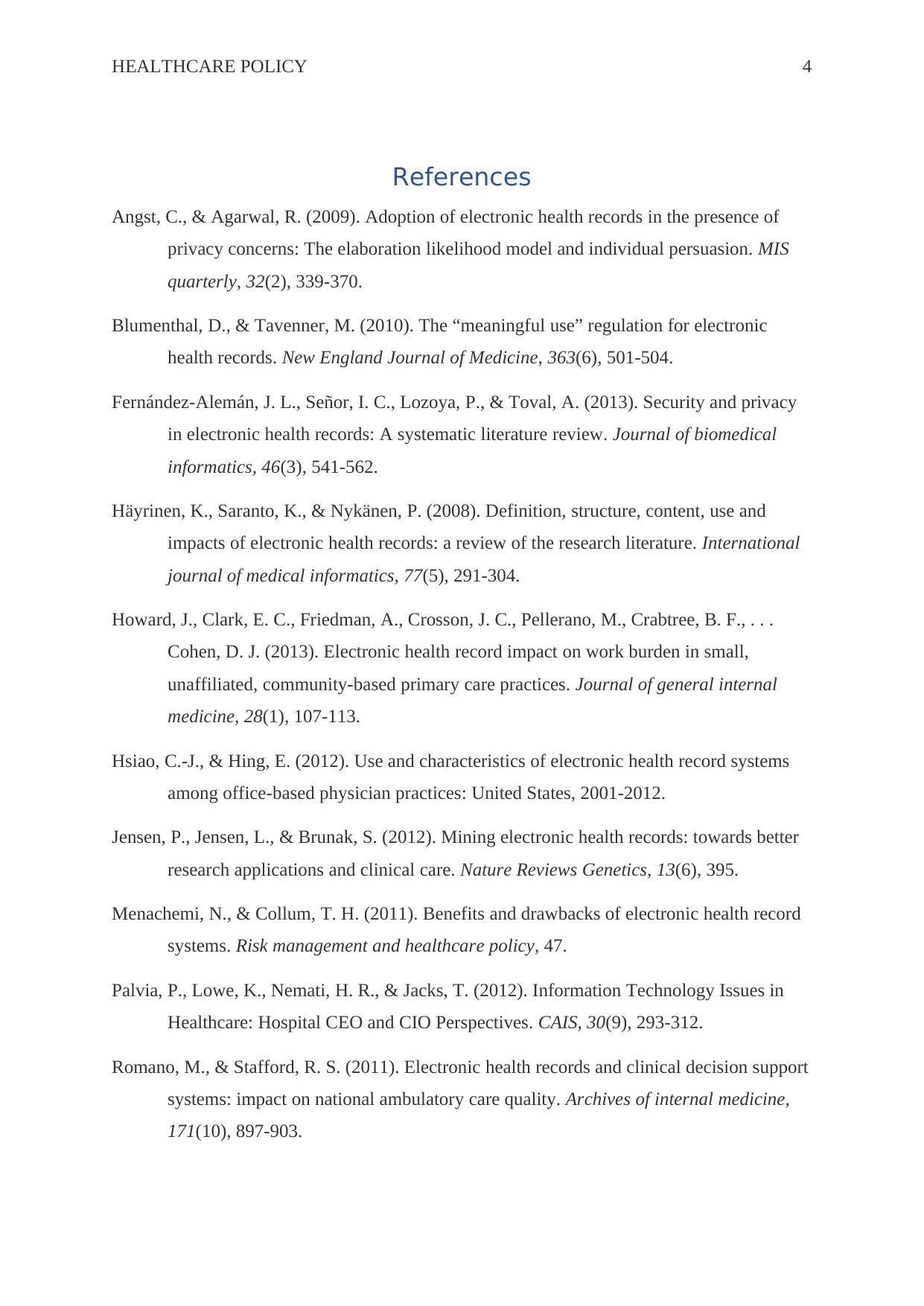
HEALTHCARE POLICY 4
References
Angst, C., & Agarwal, R. (2009). Adoption of electronic health records in the presence of
privacy concerns: The elaboration likelihood model and individual persuasion. MIS
quarterly, 32(2), 339-370.
Blumenthal, D., & Tavenner, M. (2010). The “meaningful use” regulation for electronic
health records. New England Journal of Medicine, 363(6), 501-504.
Fernández-Alemán, J. L., Señor, I. C., Lozoya, P., & Toval, A. (2013). Security and privacy
in electronic health records: A systematic literature review. Journal of biomedical
informatics, 46(3), 541-562.
Häyrinen, K., Saranto, K., & Nykänen, P. (2008). Definition, structure, content, use and
impacts of electronic health records: a review of the research literature. International
journal of medical informatics, 77(5), 291-304.
Howard, J., Clark, E. C., Friedman, A., Crosson, J. C., Pellerano, M., Crabtree, B. F., . . .
Cohen, D. J. (2013). Electronic health record impact on work burden in small,
unaffiliated, community-based primary care practices. Journal of general internal
medicine, 28(1), 107-113.
Hsiao, C.-J., & Hing, E. (2012). Use and characteristics of electronic health record systems
among office-based physician practices: United States, 2001-2012.
Jensen, P., Jensen, L., & Brunak, S. (2012). Mining electronic health records: towards better
research applications and clinical care. Nature Reviews Genetics, 13(6), 395.
Menachemi, N., & Collum, T. H. (2011). Benefits and drawbacks of electronic health record
systems. Risk management and healthcare policy, 47.
Palvia, P., Lowe, K., Nemati, H. R., & Jacks, T. (2012). Information Technology Issues in
Healthcare: Hospital CEO and CIO Perspectives. CAIS, 30(9), 293-312.
Romano, M., & Stafford, R. S. (2011). Electronic health records and clinical decision support
systems: impact on national ambulatory care quality. Archives of internal medicine,
171(10), 897-903.
References
Angst, C., & Agarwal, R. (2009). Adoption of electronic health records in the presence of
privacy concerns: The elaboration likelihood model and individual persuasion. MIS
quarterly, 32(2), 339-370.
Blumenthal, D., & Tavenner, M. (2010). The “meaningful use” regulation for electronic
health records. New England Journal of Medicine, 363(6), 501-504.
Fernández-Alemán, J. L., Señor, I. C., Lozoya, P., & Toval, A. (2013). Security and privacy
in electronic health records: A systematic literature review. Journal of biomedical
informatics, 46(3), 541-562.
Häyrinen, K., Saranto, K., & Nykänen, P. (2008). Definition, structure, content, use and
impacts of electronic health records: a review of the research literature. International
journal of medical informatics, 77(5), 291-304.
Howard, J., Clark, E. C., Friedman, A., Crosson, J. C., Pellerano, M., Crabtree, B. F., . . .
Cohen, D. J. (2013). Electronic health record impact on work burden in small,
unaffiliated, community-based primary care practices. Journal of general internal
medicine, 28(1), 107-113.
Hsiao, C.-J., & Hing, E. (2012). Use and characteristics of electronic health record systems
among office-based physician practices: United States, 2001-2012.
Jensen, P., Jensen, L., & Brunak, S. (2012). Mining electronic health records: towards better
research applications and clinical care. Nature Reviews Genetics, 13(6), 395.
Menachemi, N., & Collum, T. H. (2011). Benefits and drawbacks of electronic health record
systems. Risk management and healthcare policy, 47.
Palvia, P., Lowe, K., Nemati, H. R., & Jacks, T. (2012). Information Technology Issues in
Healthcare: Hospital CEO and CIO Perspectives. CAIS, 30(9), 293-312.
Romano, M., & Stafford, R. S. (2011). Electronic health records and clinical decision support
systems: impact on national ambulatory care quality. Archives of internal medicine,
171(10), 897-903.
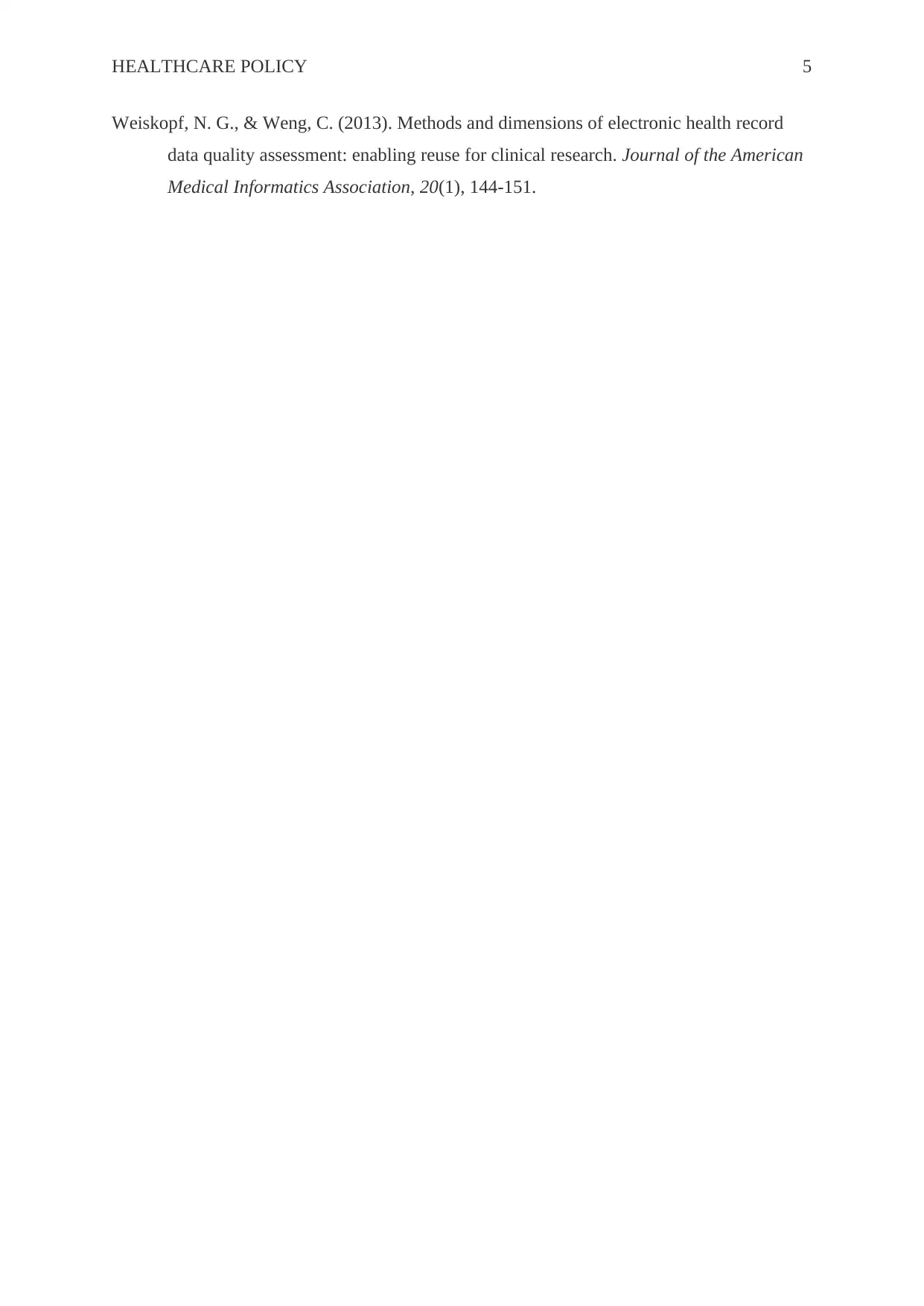
HEALTHCARE POLICY 5
Weiskopf, N. G., & Weng, C. (2013). Methods and dimensions of electronic health record
data quality assessment: enabling reuse for clinical research. Journal of the American
Medical Informatics Association, 20(1), 144-151.
Weiskopf, N. G., & Weng, C. (2013). Methods and dimensions of electronic health record
data quality assessment: enabling reuse for clinical research. Journal of the American
Medical Informatics Association, 20(1), 144-151.
⊘ This is a preview!⊘
Do you want full access?
Subscribe today to unlock all pages.

Trusted by 1+ million students worldwide
1 out of 6
Related Documents
Your All-in-One AI-Powered Toolkit for Academic Success.
+13062052269
info@desklib.com
Available 24*7 on WhatsApp / Email
![[object Object]](/_next/static/media/star-bottom.7253800d.svg)
Unlock your academic potential
Copyright © 2020–2025 A2Z Services. All Rights Reserved. Developed and managed by ZUCOL.





